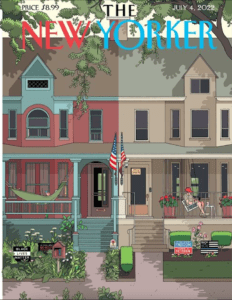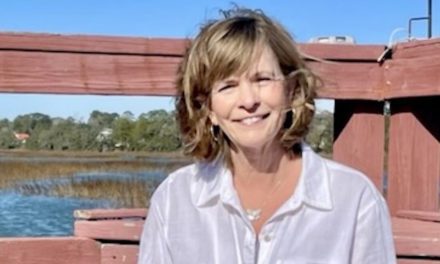 Have you seen the latest issue of The New Yorker? It’s been years since I subscribed, but the cover art was going around Facebook last week, just before the 4th of July.
Have you seen the latest issue of The New Yorker? It’s been years since I subscribed, but the cover art was going around Facebook last week, just before the 4th of July.
The image, entitled “House Divided,” was created by artist Chris Ware, who spoke about it in an interview, saying, “I was taught in school that the American experiment was rooted in consensus and compromise. But Internet algorithms have put us at an uncompromising moment of nonconsensual reality. Sometimes it seems the only thing that the left and right can agree on is that compromise is laughably naïve.”
Still clinging desperately to that old-timey notion of “consensual reality,” your naïve correspondent decided to run her own little experiment. I posted the New Yorker cover on my Facebook page, asking my FB friends to share their thoughts and feelings in the comment boxes.
Mind you, these were the same FB friends about whom I’d recently written:
“I have two distinct groups of FB friends who talk politics here anymore. (And plenty who don’t.) I’ve watched over the past many years as those two groups have grown increasingly insular and isolated from each other – blocking, unfollowing, and unfriending each other. (This I know, because they often boast about it.) I’ve watched their conversations become increasingly self-affirming, as they shore up their respective world views without the challenge of opposing perspectives. I’ve watched each group slowly become detached from the reality of the other group – its own understanding of itself, what its members actually think, feel, and value – and embrace, instead, a grossly distorted and hideous caricature. At this point, it seems each group believes the other to be not only deeply misguided, but actually evil. I believe my Facebook feed is a microcosm of the country. And it scares the hell out of me.”
So back to the New Yorker cover and my experiment. Are we really a house divided? At press time, my findings were unclear. But we were about 300 comments in, and certain trends had emerged.
For starters, lots of conservatives were offended by the cover. They felt misrepresented by their “side” of the house.
One, a retired journalist who runs a community garden, was particularly insulted, calling the cover “a provocative pair of stereotypes – the tolerant, book-sharing hippie gardeners on the left and the militaristic conquerors of nature on the right.”
Another conservative wrote, “this cover clearly depicts the liberal side as the prettier side (better garden, open door, little library, prettier building, etc). Media bias much?”
There were several other such comments, none of them unexpected. Sometimes I think the entire conservative movement is predicated on nothing so much as a deep simmering anger at being repeatedly misunderstood by the media. (Not a baseless grievance, in my observation.)
The reliable liberals in the thread were true to form, as well. Though they had no problem with their side of the house – it’s the pretty side, after all – they found things to complain about, too. For them, the cover was too rich and too white to represent America.
“I see people of different political persuasions,” one friend wrote, “both of whom apparently enjoy a level of prosperity that far too many Americans can only dream about.”
Another said, “Although I can only see the hands on the left, I think they are both white. The BLM sign notwithstanding, there’s a narrow demographic of race and class depicted here.”
Another aired a more general political grievance, saying, “I think it would be profoundly more accurate if the fists of 6 Supreme Court justices were crushing both houses.”
The comments above are some of the tamer, more civil responses I saw. There were some pretty harsh ones, too. Somebody suggested that those with BLM and “In This House We Believe” signs in their yards have a “broken moral compass.” Somebody else cracked that those on the left had their curtains closed because they were “making Molotov cocktails.” Several people pointed out the security camera on the right – reflecting “fear” – contrasting it with the “welcoming” open door on the left.
While on a much-needed break from mining these comments, I web-surfed my way into an article from the New York Times that began like this:
“Pressed by Supreme Court decisions diminishing rights that liberals hold dear and expanding those cherished by conservatives, the United States appears to be drifting apart into separate nations, with diametrically opposed social, environmental and health policies. Call these the Disunited States.”
So much for my break. I finished the article, even more depressed that when I’d started it, then returned to the FB thread.
And reader, that’s when I started to feel a wee bit more hopeful. In my absence, the discussion had bloomed. It was no longer a binary, left vs. right blueprint for a coming Civil War, but a sprawling, flowering thing of rococo twists and turns, nuance and detail.
Here are some sample stitches from that long and winding thread:
“ . . . Perhaps we are not as heavily divided as social media portrays. The house on the left is welcoming with a wild and free vibe, wooden railings, little library, hammock – even the windows look happier. House on the right with manicured lawn appears guarded and a bit uptight. Almost sterile. The geraniums are flourishing, so all is not lost… I would totally love to chat with the person on the right as much as the left. I’d be toting a tomato pie up those steps and complementing him on his pretty geraniums. There is always middle ground, in most cases. Even if his coffee mug has ‘Liberal Tears’ on it.”
“… I think it’s just two different nice styles. The geraniums and roses are pretty. The boring house has a nice open window in the back so you can see through it, which seems welcoming and airy. So I think they’re both appealing to different people, not necessarily exclusively right/left.”
“Generalizations. Part truth, part fiction. Neighbors not talking to one another, or listening.”
“I am an immigrant, and from outsiders’ position it is weird how one’s political views became a lifestyle brand! If I ask someone ‘is there a good salad place,’ I’ll get the answer like ‘there’s plenty, this is a pretty liberal area.’ Or if it’s in Bible country, that means barbecue is divine and meat falls off the bone. Which party you vote is associated with a person’s values, but more than that it’s associated with a certain lifestyle. And that has a very performative part to it.”
“I love the cover. I think it shows how divided we are as a nation but also how insular we are, stuck in our own ruts, our backs to our adversaries, heads in our phones, more interested in those online than those right next to us.”
“If we back up a step, maybe the interesting thing is that we (as viewers) are digging for differences and forcing each of the houses into well-defined stereotypes. There is always the option of simply seeing two neighbors coexisting, each peacefully enjoying a quiet afternoon.”
So many (more) great comments, so little space. For the full conversation, check out my Facebook page.
Let’s keep talking, y’all.








